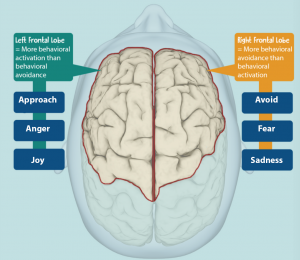Chapter 7: Physiological Measures of Emotion
3 Theories of Hemispheric Lateralization
Currently, three theories of hemispheric lateralization (also called frontal asymmetry) exist. These theories hypothesize how the hemispheres of the brain are related to our emotional experiences. Hemispheric lateralization was described earlier in the EEG section.
Right Hemisphere Hypothesis
The right hemisphere hypothesis suggests that the right hemisphere of the brain processes emotions, while the left hemisphere is not involved. The right hemisphere is thought to control the behavior, cognitive appraisal, and subjective feelings components of emotion. Brain lesion studies support the right hemisphere hypothesis, while fMRI and EEG studies do not provide strong support (Schirmer & Kotz, 2006). Damage to the right hemisphere of the brain or left side of the body has been linked to volatile emotions and inability to identify emotions in others’ facial expressions (Adophs et al., 2000, 1996). But, keep in mind these findings only tell us what happens when the right side is damaged, but does not tell us anything about if the same thing happens when the left side of the brain is damaged. The Wada test is a methodology that can help us to test the functions of the right and left hemispheres separately. The Wada test occurs when a sedative sedates only one side of the brain and body and effectively puts one side of the brain to sleep. But, the other side of the brain and body continues to function normally. Researchers used the Wada test to evaluate how the right and left side of the contribute to emotional experiences. When the Wada test sedated the right side of the brain and participants were shown a photo on the left side of their visual field, participants reported less intense emotions than when the right side was functioning normally (Ahern et al., 1991). When the Wada test sedated the left side of the brain and participants were shown the same face in the right visual field, participants reported no change in emotion. Thus, these findings do suggest the right hemisphere might control arousal or intensity of emotions, but not necessarily valence or specific emotions.
Valence Hypothesis
The valence hypothesis theorizes that the right hemisphere of the brain controls negative emotions and the left hemisphere controls positive emotions. There is some evidence to support this hypothesis. A Wada test to sedate the left hemisphere caused an increase in sadness – because now the right hemisphere is dominant (Demarree et al., 2005). Further, damage to the right hemisphere makes it harder to recognize negative emotions in facial expressions, but not positive emotions (Adolphs et al., 1996). Finally, when people perceive negative emotions in others’ faces and when they show negative emotions on their own faces, an EEG shows more activity in the right hemisphere than the left hemisphere (Davison & Irwin, 1999).
What about the left side of the hemisphere? A Wada test that sedated the right hemisphere caused joy-like emotions, because the left hemisphere is now dominant (Demarree et al., 2005). When people perceived or showed positive emotions, the EEG similarly showed more activity in the left (vs. right) hemisphere (Davison & Irwin, 1999). Although an interesting hypothesis, some recent research suggests that difference between the left and right side of the brain is not valence, but whether people are motivated to approach or avoid.
Approach-Withdrawal Hypothesis
The approach-withdrawal hypothesis (see Figure 11) focuses on the right and left frontal lobes, instead of the right and left hemispheres as in the past studies. This hypothesis suggests that the right frontal lobe is activated for emotions that cause avoidance behavior, while the left frontal lobe is activated for emotions that cause approach behavior. This theory has been supported, in particular because anger, which motivates us to approach the person who angered us, activates the left and not right side of the brain (Harmon-Jones & Allen, 1998; Harmon-Jones & Sigelman, 2001). Some initial evidence has found that expressing fear and disgust emotions on the face resulted in less left cortical activity compared to participants who expressed no emotion and compared to participants who expressed joy and anger approach emotions (Coan et al., 2001). Interestingly, joy and anger facial expressions did not result in more left cortical activity than the control. So, most recent evidence suggests that the left side is less involved in avoidance emotions, but more work is needed to demonstrate that approach and withdrawal emotions differentially activate the left and right hemispheres.
Figure 11
Approach-Withdrawal Hypothesis

Long Description
This image presents a top-down anatomical view of the human brain, focusing on the left and right frontal lobes. Each lobe is labeled with its associated emotional and behavioral tendencies:
- Left Frontal Lobe:
- Associated with greater behavioral activation than avoidance.
- Linked to approach-related emotions such as anger and joy.
- Right Frontal Lobe:
- Associated with greater behavioral avoidance than activation.
- Linked to avoidance-related emotions such as fear and sadness.
The diagram visually contrasts the emotional and motivational roles of the two hemispheres, often used in psychological or neurological contexts to explain lateralization of brain function.

